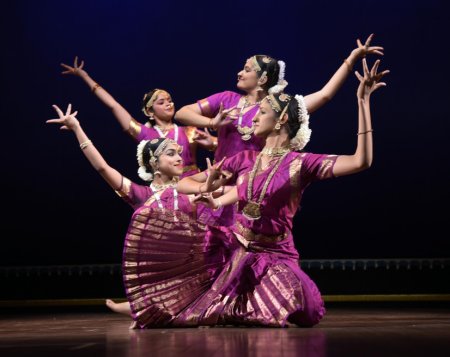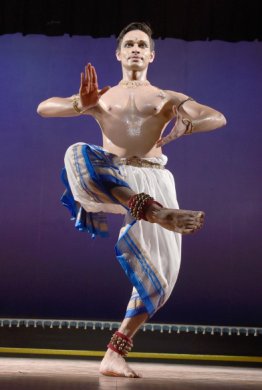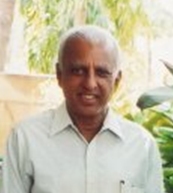
|   |

|   |
Youth in Dance Festival 2022 - Satish Suri e-mail: satishism@yahoo.co.in Photos: Shandilya Srivatsa May 16, 2022 The Youth in Dance Festival curated by the Padmalaya Dance Foundation had a unique flavour to it. The three dedicated dancers were chosen - Shreema Upadhyaya, Aishwarya Anant Karthik and Aditya P.V - to evolve a creative process, conceptualise, create and explore the layered nuances of a thematic recital based on esoteric verses of Adi Shankaracharya and compositions of Muthuswami Dikshitar placed in tandem. Devi, Skanda and Shiva were the chosen godheads to be presented by the respective artistes through music and movement.  Padmalaya Dance Ensemble Before the dancers took to the stage, the Padmalaya Dance Ensemble presented "Heramba Ganapathi," the iconic five-headed Ganapathi who rides the mighty lion symbolising the protector, who blesses that he will remove all suffering and bring eternal happiness. Ten armed, he holds the noose, the tusk, the aksharamala, the axe, the modaka and the mallet. The five heads represent the five koshas or gross subtle nature of our bodies. The son of Maheswara also points to the five cardinal directions that symbolise the five elements, namely - Earth, Water, Fire, Wind and Space. The artistes Ranjitha Kumar, Poshini Zunzurwad, Aninditha Ashok and Tara Bailkeri, using mime, postures and formations highlighted the many features of the saguna aspect of Ganapathi. The finely articulated rendition of the narrative including the rhythmic sequences was embellished by the clarity of the choreography. The orchestral accompaniment on a recorded track highlighted the presentation.  Shreema Upadhyaya Shreema Upadhyaya with her natural flair and impactful stage presence, presented Devi as the Supreme Goddess. In his introductory remarks about the conceptualisation of the piece in three segments, acharya Praveen Kumar remarked that "Shankaracharya glorified the Goddess in the aspect of beauty, knowledge, power and shakti. Muthuswami Dikshitar exemplified her with music filled with the importance of the temple, the rituals, and the attributes of the Goddess." In a three-part sequential narrative exemplified by the delightful music composition, that began with the signature notes of a Dikshitar kriti "Sri Varalakshmi namasthubhyam Vasu prade, Sri Sarasa pade rasa pade sapade pade" - The one residing in the lotus, the abode of Rasa - one with beautiful feet - salutations to you the giver of wealth and whose feet are beautiful as the lotus. The narrative moves on to Adi Shankaracharya's hymn on Sharada with verses from Sharada Bhujangam. I worship Mother Sharada who is my eternal Mother. Brimming with mercy in her glance, sharing a symbol of wisdom in her hands, always awakened by the art forms and always wearing ornaments, I pray that Mother Sharada is forever my Mother. The composition finally culminated with Dikshitar's "Sri Varalakshmi namasthubhyam." The second segment had the exquisite hymn in praise of Goddess Annapurneswari, who holds in one hand a jewelled bowl full of grains, symbolising abundant nourishment. She gives to all. She is the Mother Goddess, the sustainer of life, the compassionate Mother of all beings. The final segment comprised a Dikshitar kriti "Varaheem Vaishnavi" endowed with the strength of the Trimurthis and armed with a potent weapon to destroy the demon. The kriti eulogises Varahi residing in the 16th prakara of the Sri Chakra. The marvellous blend of the esoteric verses of Shankaracharya and the kritis of Dikshitar provided an ideal canvas for Shreema to explore the layered nuances of the composition through a movement vocabulary that sparkled with delightful vignettes, postures, geometric perfection, evocative abhinaya and footwork articulating the rhythmic sequences. The unique and distinctive choreography of Praveen Kumar conferred grace and dignity to the presentation. As the tempo increased the artiste's response was equally emphatic to the vibrant mnemonic syllables and the ensuing statuesque postures enthralled the audience. The final freeze to conclude the presentation was the visual imagery of the Goddess in a sitting posture which sort of froze in time a multitude of actions that glorified the beauty, grandeur and power of the Goddess. The musical ensemble with Srivatsa (vocals), Mahesh Swamy (flute), Lingaraju (mridangam) and Praveen Kumar (nattuvangam) provided the melodic content and delightful musical phrasing that uplifted the performance.  Aishwarya Anant Karthik Aishwarya Anant Karthik, a disciple of Prof.Sudharani Raghupathy, presented ‘Namami Guruguham,' an exposition on Skanda choreographed by Aishwarya Anant and Gayathri Ramaratnam. In the concept note read out by Gayathri Ramaratnam, she describes the origin of the first kriti composed by Dikshitar, his Ankita Naama in praise of his adi Guru Skanda. It is said that Lord Muruga, the presiding deity of Tiruttani visited in the guise of an old man and blessed Dikshitar, "Sri nathadi guruguho jayathi jayathi" set to raga Mayamalavagowla signifying victory to the Lord Guruguha who is adored by all gods. The second segment describes the birth through the third eye of Shiva after Devas strategically send Manmatha to shoot his darts of love at Lord Shiva in meditation. Manmatha is reduced to ashes resulting in a ball of fire. While Parvathi worships him resulting in his appearing as six babies, he is being nurtured and brought up by six Kartika maidens and finally, Parvathi comes lovingly to take him, when he assumes six faces with twelve arms and becomes known as Karthikeya. Parvathi also gives him the spear (Vel). The rendition resonated through the Dikshitar kriti "Parvathi Kumaram bhavaye satatam" in Natakuranji raga. Meditate always on the son of Parvathi who is incarnated in the fount of needs. This was followed by verses from Adi Shankaracharya's Subrahmanya Bhujangam -"Mayuura adhiruuddam mahaa vaakya guruddham" (salutations to Sri Subrahmanya whose form is mounted on a peacock represents the deepest secret of the Upanishadic Maha Vakyas). The narrative also included the story of Skanda imparting the Pranava Mantra "AUM" to his father Shiva after Brahma pleads ignorance about its meaning. The Dikshitar kriti in raga Ananda Bhairavi, "Dandhayudha panim dandita srenim dayanidhi baje re hrdyasatatam sura vinutham" (Subrahmanya bearing a staff as a weapon; one who punished the Asuras; the treasure house of mercy; the one extolled by the Devas) describes the plea of a devote requesting Lord Subrahmanya to come out of isolation from Palani. Aishwarya opened beautifully with a Pushpanjali set to raga Shanmukhapriya. She insightfully referenced stories of Lord Muruga with a vocabulary of movements personified by artistic acumen. Hand gestures and engaging footwork, the grace and precision of nritta and rhythms synergised, and found fulfilment in the overall expression. The poetic lines in the sahitya were transformed into captivating movements breathing life into the composition and executed with finesse. The spatial movements were artistically improvised and the free-flowing adavus added a special dimension to the presentation. She concluded with "kavadi chindu" in praise of Lord Muruga, which describes pilgrims carrying their load of offerings on a stick supported on one's shoulders to the temple at Palani. Carrying the offerings constitutes the kavadi (bondage of debt). With the pleasing sway of movement, the dancer concluded with the hymn "Aum Saravana bhava." Excellent orchestral support by Srivatsa (vocals), Lingaraju (mridangam), Mahesh Swamy (flute), and Gayathri Ramaratnam (nattuvangam) set the tone and tenor to enhance the presentation.  Aditya PV The finale for the day was a presentation by Aditya P.V. Dikshitar's tryst with western music was the inspiration for nottuswarams (Western notes / Carnatic swarams), lyrics based on Sanskrit verses and given a western feel to the Carnatic rendition. In his explanatory statement, Aditya mentioned that he chose three nottuswarams.The pieces chosen referenced through a book on Jatiswarams in Telugu offered to Charles Philip Brown, a scholar in Telugu serving the East India Company, provided the base for his exposition on Shiva. He began with "Nagendra Haraya" which narrates the essence of five cosmic elements that define the existence of Shiva and delightfully wove the three nottuswarams of Dikshitar into the rendition. "Chintaye ham sadhaa" followed by "Sakala suravinutha" and "Parvathi pate" all in Shankarabharam raga that evoked a feeling of joy. The delightful musical refrains of the flute (Mahesh Swamy) and the percussion (Harsha Samaga) defined the flow of the tempo and qualified the composition with intrinsic beauty. Noteworthy was the eloquent vocalisation (Rohit Bhat) that had the western feel of a march past. His narrative was defined further by selected verses from Shankaracharya's Magnus opus Sivananda Lahari. "The hastas held a lot of metaphors, philosophy and deep meaning," Aditya remarked. He mentioned a few of them. The deer - wandering mind; Gajasura - the six sins that Shiva vanquished; Summer heat - our plight; Hala Hala - our greed, Chataka bird - our desires; Peacock - your devotees dancing; the fully opened feathers of the peacock - Jata; Monsoon - blessings. Music for the piece was composed by G.Srikanth and Konnakol by Somasekhar Jois. The portrayal by Aditya was brisk, zesty and exuberant with beautiful lines. His body language brought out the radiance in the depiction of Shiva. His torso movements with a measure of brilliant flexes depicting the snake on Shiva's neck was slick. The attractive choreography incorporated intricate and vibrant jathis eloquently woven into the movements. His versatility of execution in exploiting the stage space with leaps was an enriching experience. The sanchari of Kannappa Nayanar and his unflinching devotion to Lord Shiva was visually touching and hallmarked by sensitive abhinaya. The visual imagery enforced the impression of strength that left an indelible impression. The narrative was augmented by the excellent music ensemble with Rohit Bhat (vocals), Harsha Samaga (mridangam), Mahesh Swamy (flute), Pradesh Achar (violin) and Shruti Gopal (nattuvangam). The rhythmic chanting of mantras by Mahesh Swamy before the start and conclusion of the depiction of verses of Sivananda Lahari concluded the proceedings with "Aum Shanti Shantihi". The festival was a landmark in itself calling for innovation in music composition, choreography, creativity and execution. Padma Murali of the Padmalaya Dance Foundation must be complimented for the opportunity given to the dancers to create and present their art in an auditorium filled with rasikas.  Bangalore based Satish Suri is an avid dance rasika besides being a life member of the Music and Arts Society. |